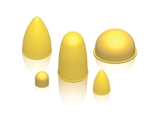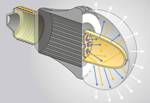Remote-phosphor systems can yield uniform light from a large emitting surface,and can eliminate the need for a secondary optic to achieve the desired light distribution,as MARTIN SCHIEL explains.
As high-power LEDs have proved their ability to deliver the luminous flux and efficacy needed to satisfy an ever-growing variety of applications,component manufacturers have turned their attention to refining the quality of the light produced.Indeed the lighting industry is demanding solid-state lighting(SSL)technology that can deliver consistent color and light output over relatively-large surface areas.Achieving color consistency with phosphor-converted white LEDs can be costly and/or difficult.Remote-phosphor technology,however,can deliver color consistency and efficacy gains.

FIG.1.
Technical improvements in the quality of light will support the efforts of LED lighting vendors to produce replacements for incandescent or compact-fluorescent lamps in industry-standard form factors,or for fixtures that traditionally use ordinary fluorescent tubes such as troffers and other recessed ceiling lights.
To meet the established form factors for troffer lights,for example,equivalent LED retrofits will need to have a large light-emitting surface.This challenges designers to achieve smooth and even illumination across the entire surface.In fact,a uniform and consistent light-emitting surface,unmarked by identifiable point sources and exempt from noticeable chromaticity variation,is desirable in many applications ranging from large industrial lights to small bulbs for domestic use.
In addition,the characteristics of the light emitted by each LED in a bulb or fixture containing multiple LEDs must be closely matched.However,variations in manufacturing processes can result in LED chips having different flux,color and forward voltage from unit to unit,which may not be acceptable for the end product if not dealt with effectively.
LED manufacturers have developed various ways to overcome such effects.The most familiar of these is LED binning:the LEDs are tested and then categorized into one of a number of groups,or bins,according to the characteristic of the light produced.Fulfilling individual customer orders from a small number of such bins–or even a single bin–ensures that each customer will receive devices that are matched in performance,with the closeness of the match required depending on the application.
Freedom from binning
The binning system,although effective,has some disadvantages:it can be difficult for customers to understand,and lead-time issues may arise if the number of LED units available in any one bin is insufficient to satisfy a complete order immediately.It is worth noting,however,that LED manufacturing processes have significantly improved,allowing binning limits to be revised.Smaller bins have been published,as defined by the American National Standards Institute(ANSI),and some LED manufacturers even offer sub-ANSI binning.

FIG.2.
An alternative approach is to adjust the characteristics of the light from each LED using optical techniques to normalize the wavelengths to within a certain range.This can reduce or eliminate the need for binning.For example,this has enabled Philips Lumileds to introduce its new"Freedom from Binning"product ranges such as the Luxeon A family.By exactly matching the phosphor coating to the wavelength of light emitted by each royal-blue LED die,a technique the company calls Lumiramic phosphor technology,Philips Lumileds can achieve remarkably uniform outputs in terms of the color temperature of white light(see Fig.1).
Remote-phosphor technology
While conventional white LEDs offer the advantage of providing an integrated device with a known white-light output,they operate as bright point sources of light,which causes the uniformity problems alluded to above in applications with a large light-emitting surface.
Remote-phosphor technology is now gaining acceptance in applications that require uniform illumination and high efficiency,such as downlights,high-bay lighting,replacement lamps and others.
A lighting fixture featuring remote-phosphor technology typically consists of an LED board containing royal blue LEDs,a mixing chamber,and a remote-phosphor element,as shown in Fig.2.Using an arrangement such as this,lighting designers can achieve a range of color rendering index(CRI)and correlated color temperature(CCT)values for white light through the use of different remote-phosphor elements with the same LED board.Further,LEDs from one or a combination of two royal-blue color bins can be used,which simplifies inventory management.
FIG.3.
The remote-phosphor element also has a significant diffusing effect that can help achieve smooth lighting free from visible point sources and chromaticity variations.In addition,since the phosphor element is positioned remotely from the LED source,heating of the phosphor by the LED is reduced,ensuring excellent spectral stability over time.
The ChromaLit range of remote-phosphor elements,manufactured by Intematix and available from Future Lighting Solutions,offers a wide choice of forms and sizes for system designers wanting to implement a remote-phosphor lamp.The ChromaLit elements are available in seven categories,including round,square,linear and panel formats in a polycarbonate material.
ChromaLit XT glass remote-phosphor elements,introduced at Light+Building 2012,allow at least three times greater lumen density,and appear neutral in color when the lamp is off.Whereas a downlight using a 61.5-mm diameter ChromaLit element can comfortably achieve 1000 lm,with the use of ChromaLit XT at the same diameter,the lumen output can be increased to 3000 lm in the same enclosure.
The ChromaLit plates,such as circular optics,are two-dimensional elements suitable for applications with a flat light-emitting surface.Three-dimensional shapes such as Ellipse,Candle and Dome are available for applications such as retrofit lamps and pendant lights(see Fig.3).Fig.4 shows how a three-dimensional ChromaLit element may be used in a domestic retrofit bulb.
Completing the design
Remote phosphor designed into a retrofit bulb enables high output density,since the reflected light is spread over a large phosphor area and is efficiently recycled to exit the fixture.The LEDs,the phosphor element,the mixing chamber,and the reflective material all play a vital role in influencing the overall efficiency of the fixture.

FIG.4.
For the ChromaLit 3D elements,conversion efficacy is dependent on the combination of CCT and CRI.Both conversion efficacy and color consistency are closely linked to the characteristics of the royal-blue LEDs.While the peak wavelength of the LED is important for radiometric requirements,the dominant wavelength is the pure(monochromatic)wavelength that has the same perceived color as the source.For this reason,dominant wavelength is the defining parameter for the phosphor element.The dominant wavelength should lie between 450-460 nm for optimal performance.
Philips Lumileds'Luxeon Rebel ES Royal Blue offers two bins that provide the wavelength required for these phosphor elements.This LED provides a typical flux of 1030 mW at 700 mA and has a superior hot/cold factor that enables it to maintain a record 50%conversion efficiency even at elevated temperatures.
The mixing chamber is highly important when designing with remote phosphor technology.In retrofit applications for instance,typically using a ChromaLit 3D element,this consists of a highly reflective PCB cover with holes for the LEDs.Reflective surfaces are needed to direct as much flux as possible from the LED source to the phosphor element.Optimal design can potentially increase the efficacy of the luminaire by around 6%.
Several types of materials may be suitable.To cite one example,Furukawa Electric Co.produces a polyethylene terephthalate(PET)-based material that offers 99%reflectivity and can handle temperatures up to 177°C,and can be die-punched to any shape depending on the chamber dimensions.
Special care must be taken over thermal design,as with all LED lighting designs.Tests should be performed using prototypes as close to the final design as possible.The main aspect to consider is the junction temperature of the LED and the maximum temperature within the ChromaLit material,which,for ChromaLit 3D elements,should be kept below 110°C after stabilization.
Light distribution
When doing a comparison between remote phosphor and a white LED solution,it can be shown that the former provides improved thermal performance of the blue LED and phosphor and improved light extraction through an efficient mixing chamber.Also,the design can eliminate the need for a secondary optic to achieve the desired light distribution.For this reason,the Energy Star requirement for omnidirectional integral bulbs is much more easily achieved with a 3D remote-phosphor solution than by using white LEDs(see Fig.5).For the latter,either secondary optical systems are required,or the LEDs must be placed in a three-dimensional arrangement.In both cases,the result is increased system complexity and cost.

With a remote-phosphor solution,by contrast,it is possible to use five blue LEDs at a hot ChromaLit conversion efficacy of 177.6 lm/W at 10.5W input power.Assuming a value for the LEDs'wall-plug efficiency of 49%and a glass diffuser efficiency of 95%with no secondary optics needed,the total output is 868 lm at 82.7 lm/W.This is a net increase in efficacy of 24%.Neither example accounts for power supply/driver efficiency.With the LED count reduction and the elimination of secondary optics,the total cost of the remote-phosphor solution is also competitive.





